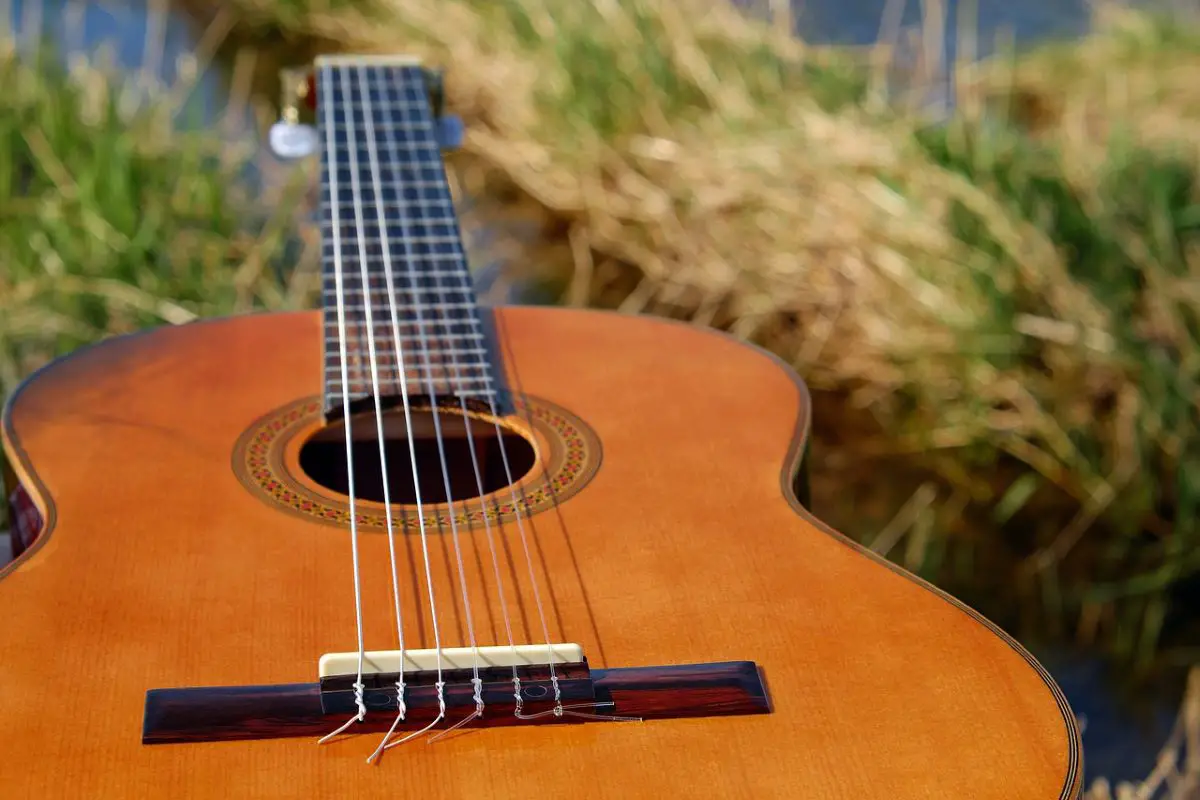Are you new to the world of guitars? It can be daunting to know where to start, especially when one of the first things you need to learn is how many strings a guitar has.
A guitar can have anywhere from 4-8 strings, depending on the guitar you’re looking at. Most guitars have six strings. However, some guitars have seven, eight, or even more strings. To see the number of strings a guitar has, look at the headstock, which is the part of the guitar closest to your face when you play it. The headstock will usually show how many strings a guitar has.
A standard guitar usually has six strings, three on the top and three on the bottom. These strings are named EADGBE (from lowest to highest) and are tuned according to these notes.
What Are the Different Types of Guitars?
There are many different types of guitars, and each one is suited to a different style of music. Let’s look at some of the most popular types of guitars.
The Acoustic Guitar
Acoustic guitars have hollow bodies, which means they have a hole in the middle of their bodies to create resonance and amplify the sound. These guitars are perfect for playing by the campfire or any other situation where you don’t have an amp handy.
The Electric Guitar
On the other side of the spectrum, electric guitars have solid bodies and need to be plugged into an amplifier to produce sound. You can’t just play them anywhere because they don’t produce sound independently. If you want to hear how they sound, you’ll need a loud amplifier or headphones to listen through.
The Classical Guitar
Classical guitars are acoustic guitars that feature nylon strings instead of steel strings; which results in a very different tone than what you get from regular acoustic or electric guitars. They’re commonly used in classical music, but they’re also very versatile instruments that can be used in many different styles of music.
Four String Bass Guitars
Four-string bass guitars are the most common form of bass guitar that you will see. They have four strings, and they are tuned to E-A-D-G. The strings on the four-string bass guitar are made from different materials than the strings on other types of guitars. They have a thicker gauge, made from heavier materials such as steel core wire, nickel alloy wire, or cobalt alloy wire. The strings on these types of guitars have more mass because they need to produce lower tones than other types of guitars can produce.
The difference between four-string bass guitars and other guitars is that the fretboard has less action than other guitars. The frets on this type of guitar are closer together, so there is less space between them and less space for your fingers to move around when playing them.
Five String Bass Guitars
A five-string bass guitar is a musical instrument with five strings on it. It is usually played with the fingers but can also be plucked or hit with a pick. It has a large wooden body, a long neck, and a headstock at one end where the tuning pegs are located.
The five-string bass guitar was developed in the late 1960s by jazz fusion musician Larry Graham, who wanted to play his solos an octave higher than usual. The first model was made by combining two instruments: a 4-string Gibson EB-2 and an additional low string added to create the fifth string.
In 1970 Fender released the first factory-built 5-string bass, called the Fender Precision Bass V. Many other manufacturers followed this. Today, there are many different types of five-string bass guitars available.
How Many Strings Does A Classic Guitar Have?
When you’re a budding guitarist, there’s so much to learn. From the different types of guitars and their sounds to the standard techniques like strumming and picking to the different notes and chords, you can experience a bit of an information overload when you’re just starting.
So let’s break down one of the most fundamental questions of all: how many strings does a classic guitar have?
If you’re new to this instrument, you’ll notice that the classic electric guitar doesn’t just have one string—it has six of them! This is where the term “six-string guitar” comes from. In addition, if you’ve seen or played bass guitar, which is similar in both sound and appearance but larger than an electric guitar, you’ve noticed that it has four strings. So while electric guitars are “six-string,” bass guitars are “four-string.”
Knowing this is important because when you learn where each note is on your instrument, the notes will be based on having six strings. You might hear other guitarists say things like “start on the fifth string,” or “play an F chord starting with your second string.” These instructions assume that the guitarist already knows that their instrument has six strings.
How Many Strings Do Harps Have?
Generally, harps have between 36 and 47 strings. The exact number depends on the type of harp, the maker, and the intended use.
All the variations may have different numbers of strings. For example:
- Folk or lever (non-pedal) style – between 22 and 36 strings
- Celtic or Irish (folk wire-strung) – from 20 to 30 strings
- Single action pedal – from 30 to 46 strings
- Double action pedal – from 32 to 47 strings
- Triple action pedal – from 37 to 54 strings
- Columnar or lap – from 15 to 19 strings
Which Is The Best Guitar For Beginners?
The best guitar for beginners depends on who is learning and which type of guitar they’re interested in; generally speaking, the most classic beginner guitar is acoustic.
Acoustic guitars are relatively easy to learn because they require no amplification—they can be played anywhere!
Electric guitars require an amplifier, and while they have a built-in mic, they tend to be more challenging to learn on (not impossible, just harder).
If you’re beginning with an electric guitar, make sure you get a good amp. An electric guitar without an amp isn’t going to be nearly as helpful as one with.
Conclusion
The numbering of strings on a guitar is pretty straightforward. They are numbered from the thickest string (lowest in pitch) to the thinnest string (highest in pitch). This numbering system has been around for centuries, and it’s still used today for most string instruments and some other instruments. We hope this article helped clear most of your doubts regarding the guitar.
You May Like This Article As Well:
 Being Human
Being Human



